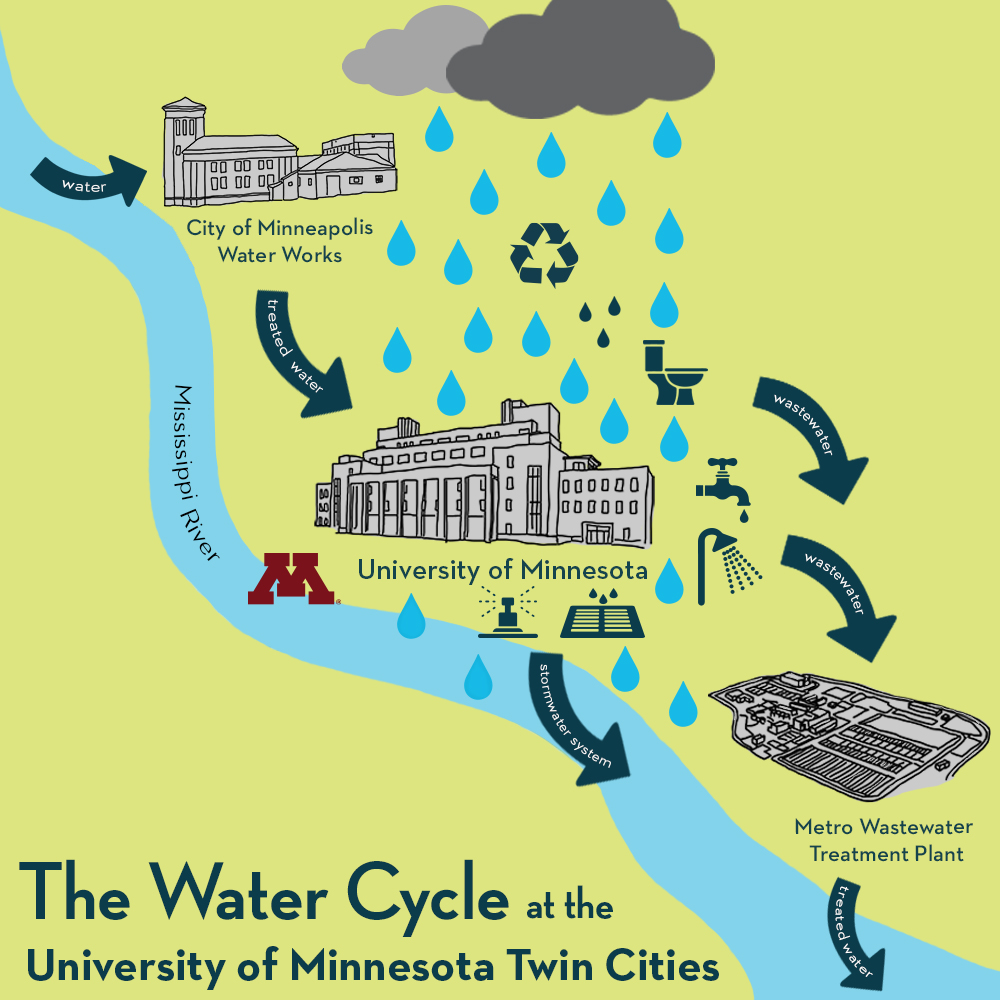
What is Stormwater?
"Stormwater runoff is generated from rain and snowmelt events that flow over land or impervious surfaces, such as paved streets, parking lots, and building rooftops, and does not soak into the ground. The runoff picks up pollutants like trash, chemicals, oils, and dirt/sediment that can harm our rivers, streams, lakes, and coastal waters. To protect these resources, communities, construction companies, industries, and others, use stormwater controls, known as best management practices (BMPs). These BMPs filter out pollutants and/or prevent pollution by controlling it at its source." (EPA)
Why is it Important?
Located on the banks of the Mississippi River, the University of Minnesota is one of largest landholders on the river from the headwaters at Itasca to the Gulf of Mexico. This means that stormwater runoff best management practices deployed on the Twin Cities campus can have a big impact! According to the Environmental Protection Agency, more than 50 communities rely on the Mississippi for daily water supply (NPS), including the University of Minnesota Twin Cities campus. Downstream communities rely on upstream communities to be good stewards of this critical shared resource.
Stormwater at the University of Minnesota
The University of Minnesota maintains Municipal Separate Storm Sewer System (MS4) permits for the Twin Cities (UMTC) and Duluth (UMD) campuses. These permits require the University to implement Best Management Practices (BMPs) as detailed in the campus-specific Storm Water Pollution Prevention Program in addressing storm water runoff from these campuses, with the goal of reducing pollutants to the maximum extent practicable.
To improve the quality of stormwater that flows from the campus into the Mississippi River and minimize negative impacts of our campus on the water and as part of the University's commitment to building a fully sustainable future and advancing the UN Sustainable Development Goals around clean water, the University of Minnesota Twin Cities has created a Stormwater Pollution Prevention Program (SWPPP). See Our Plan below.

Did You Know?
- At the 17th Avenue Residence Hall on East Bank, the “rainwater harvesting system” captures five days of rainwater in underground cisterns, and this water is reused for flushing toilets!
- There are rain gardens across campus that capture rainfall to support the growth of native plants and create healthy habitats. Learn how and why to build a rain garden and find rain gardens on campus with the Virtual Sustainability Tour.
- The University of Minnesota offers stormwater education for stormwater professionals and communities through research based and locally tailored workshops.
- Illicit discharge is defined as "any discharge to an MS4 that is not composed entirely of stormwater" ... "with some exceptions." (EPA). Examples include the dumping of motor vehicle fluids, household hazardous waste, paint, grass clippings, leaf litter, cigarettes, or animal waste. Illicit discharges are considered 'illicit' because "MS4s are not designed to accept, process, or discharge such non-stormwater wastes." Learn more about illicit discharge. If you observe an illicit discharge on campus, please report those findings to the University Health & Safety On-Call Program: [email protected] or 612-626-6004 (24-hr line)
Public Comment Form
The University of Minnesota invites the public to share comments regarding our Stormwater Pollution Prevention Program (SWPPP) (see Our Plan below) with the following public comment form, open year-round:
Questions? Contact Cathy Abene, P.E.
Our Plan: Minimum Control Measures (MCMs)
MCM 1: Public Education and Outreach
MCM 2: Public Participation/Involvement
MCM 4: Construction Site Stormwater Runoff Control
- Regulatory Mechanism
- Construction Site Implementation of Erosion and Sediment Control BMPs
- Procedure for Site Plan Review
- Procedures for the Receipt and Consideration of Reports of Stormwater Noncompliance
- Procedures for Site Inspections and Enforcement
- Education Program: Employee Construction Site Run-off Control
MCM 5: Post-Construction Stormwater Management
- Development and Implementation of Structural and/or Non-structural BMPs
- Off-site Structural and/or Non-structural BMPs
- Regulatory Mechanism to Address Post Construction Runoff from New Development and Redevelopment
- Procedure for Site Plan Review
- Education Program: Employee Post-Construction Stormwater Treatment in New Development and Redevelopment
MCM 6: Pollution Prevention/Good Housekeeping For Municipal Operations
- Municipal Operations and Maintenance Program
- Facilities Inventory
- Street Sweeping
- Parking Lot Sweeping
- Road Maintenance
- Salt Handling and Storage
- Snow Storage
- Snow and Ice Management Policy
- Landscape and Turf Management
- Dumpster Management
- Cleaning of Building Exteriors and Disposal of Waste and Wastewater
- Golf Course Maintenance
- Fueling System Spill Protection
- Vehicle Storage and Maintenance
- Equipment Storage and Maintenance
- Materials Storage Yards (Exposed Stockpiles)
- Inspection & Maintenance of Structural Pollution Control Devices
- Inspection & Maintenance of MS4 Outfalls
- Inspection & Maintenance of Ponds
- Education Program: Employee Pollution Prevention/Good Housekeeping for Municipal Operations, Winter Maintenance
- Education Program: Employee Pollution Prevention/Good Housekeeping for Municipal Operations, Responsible Party Training
- Education Program: Employee Pollution Prevention/Good Housekeeping for Municipal Operations, General Stormwater Training
- Annual Assessment of the MS4 Program

Image by SRF Consulting Group, Inc.